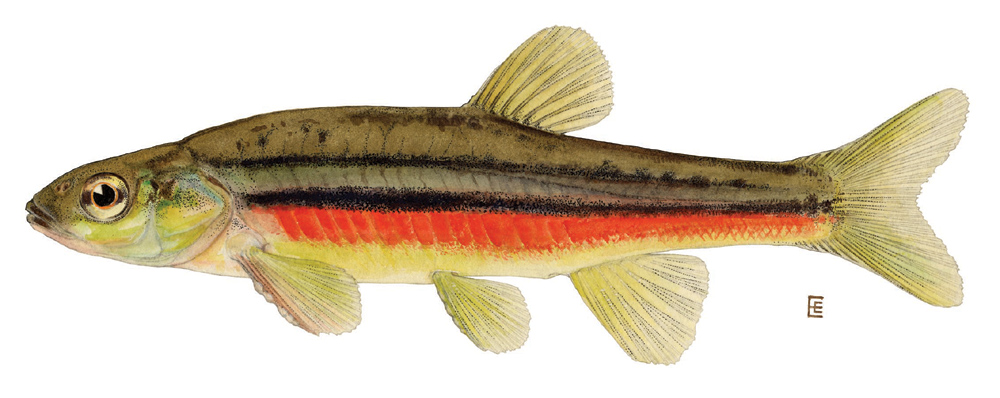Northern redbelly dace
(Chrosomus eos)

Description
The northern redbelly dace (Chrosomus eos) is a fresh water cyprinid fish, generally found in lakes and small streams in the northeastern United States and eastern Canada. Ranging from 1-3 inches, it is one of forty-four species from the minnow and carp family of Cyprinidae in these areas The northern redbelly dace is a minnow about 55 mm long with two dusky, longitudinal stripes along its sides under an iridescent silver back. The top stripe often becomes broken into dots behind the dorsal fin. Small, almost invisible scales cover its body. The lower sides of its body are white, yellow, or silver. However, during the breeding season, this area becomes brilliant red on the males. The females likewise exhibit a colorful, green ventral stripe. Helpful identifying characteristics are its long coiling intestines and the black peritoneum (lining of the body cavity). Its lateral line is incomplete and consists of 70 to 90 lateral line scales. The northern redbelly dace has thin, flexible rays called "soft-rays". It possesses a pair of pectoral fins, pelvic fins in the ventral and abdominal positions, which all are white, yellow, or silver. No adipose fin can be found after the dorsal fin on its back. The caudal fin or tail fin is notched and homocercal. This means that the tail has two lobes that are symmetrical. The northern redbelly dace ranges from Nova Scotia and Prince Edward Island westward curving in a narrow band through southern Canada, as well as, the northern and north-central United States. This encompasses Pennsylvania to Michigan, Wisconsin, and north through Minnesota to the Peace-Mackenzie drainage in British Columbia as well as the Northwest Territories. In the United States the northern redbelly dace can be found in Maine, New Hampshire, New York, Pennsylvania, Michigan, Wisconsin, Minnesota, North and South Dakota, Nebraska, and Colorado. The northern redbelly dace can be found in cool, quiet, boggy streams and lakes. The typical habitat conditions of small streams where the dace lives include: water supplied by clear, cool springs or seeps, absence of strong currents, effective cover like undercut banks and heavy brushy vegetation, and minimal large piscivorous fish populations. Small lake habitats also share these characteristics. Typically the lakes are clear and spring-fed with heavy vegetation (at least by shore) and few predatory fishes.
Taxonomic tree:







